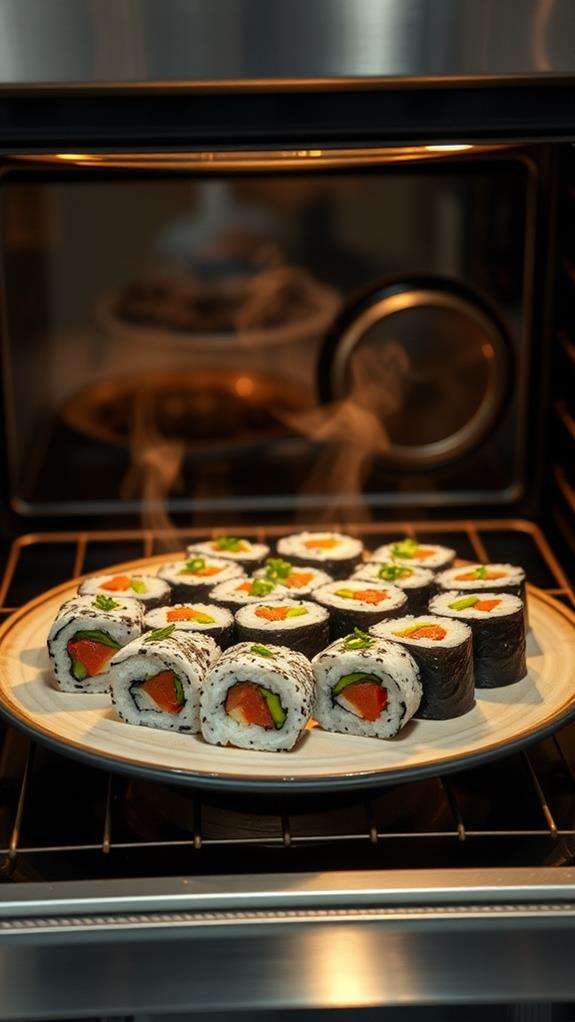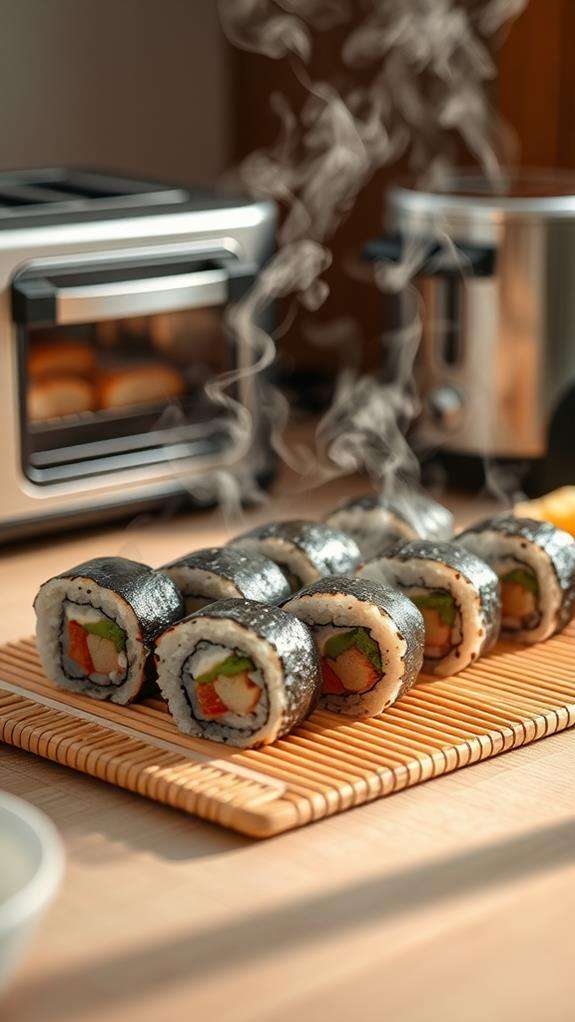How to Reheat Sushi
To safely reheat sushi, you'll need to first verify it's been properly stored in an airtight container in the refrigerator at 40°F or below for no more than three days. For best results, let the sushi reach room temperature naturally before reheating. You can use several methods: microwave at 40-50% power in 10-second intervals with a damp paper towel cover, warm in a 300°F oven for 5-7 minutes, or use an air fryer at 325°F for 3-5 minutes. Always check for signs of spoilage before reheating, and maintain proper moisture levels to prevent the rice from drying out. These basic steps will get you started, but there's much more to perfecting the art of reheating sushi.
This post may contain affiliate links. If you make a purchase through these links, I may earn a commission at no additional cost to you. Additionally, portions of this post may be generated using artificial intelligence (AI) technology. While we strive for accuracy, please be aware that AI-generated content may not always be perfect and should be fact-checked when necessary.
The Spatula Scoops
- Microwave sushi at 40-50% power in 10-second intervals, covered with a damp paper towel, for up to 30 seconds total.
- Warm sushi in a preheated 300°F oven for 5-7 minutes, covered with foil and a damp paper towel.
- Use an air fryer at 325°F for 3-5 minutes, flipping halfway through for even heating.
- Allow refrigerated sushi to reach room temperature naturally for the gentlest reheating method.
- Remove cold-served ingredients like lettuce before reheating, and ensure internal temperature reaches 145°F for safety.
Safe Storage Before Reheating

Food safety begins with proper storage of your leftover sushi. When you're planning to store sushi for later reheating, you'll need to place it in an airtight container immediately after your meal. This vital step helps prevent cross-contamination with other foods in your refrigerator while maintaining the sushi's freshness. To elevate your kitchen decor and guarantee a safe food storage environment, consider applying design ideas like geometric patterns to your kitchen space.
You shouldn't keep your leftover sushi in the refrigerator for more than three days, even if it's made with fully cooked ingredients. The risk of bacterial growth increases dramatically beyond this timeframe, potentially leading to foodborne illness. Before you consider reheating your stored sushi, check for any signs of spoilage, such as an unusual odor, slimy texture, or discoloration. If you notice any of these warning signs, it is vital to discard the sushi immediately.
Your food safety practices are particularly important if you're preparing sushi for people with compromised immune systems, elderly individuals, or young children. While proper storage can help maintain quality and reduce health risks, remember that sushi is best consumed as fresh as possible, ideally within the first 24 hours of refrigeration.
Room Temperature Method

Taking your sushi out of the refrigerator and letting it reach room temperature is one of the gentlest methods for reviving its texture and taste. This gentle approach is similar to how proper practices from industries such as palm oil production emphasize careful handling to maintain quality. You'll want to remove your sushi from its storage container and place it on a clean plate for 15-20 minutes, making sure the room isn't warmer than 72°F (22°C). While this method works well for most types of rolls and nigiri, you shouldn't leave any raw fish preparations at room temperature for longer than 30 minutes to maintain food safety standards.
Room Temperature Guidelines
The simplest approach to reviving refrigerated sushi is letting it reach room temperature naturally. When you're ready to reheat sushi, remove it from your refrigerator and place it on a clean, dry plate. The process typically takes 30-45 minutes, depending on your room's ambient temperature and the sushi's thickness.
Follow these essential guidelines to guarantee food safety and prime taste:
- Don't leave sushi out for more than one hour if it contains raw fish, as bacteria can multiply rapidly at room temperature
- Place the sushi away from direct sunlight or heat sources, which can cause uneven warming and potentially compromise food safety
- Cover the sushi loosely with a paper towel while it comes to room temperature to prevent moisture from condensing on the surface
You'll know your sushi has reached the right temperature when the rice feels soft and pliable, not hard or dry. The nori (seaweed) should also regain some of its original texture, though it won't be as crisp as when first served. Remember to consume the sushi promptly once it's reached room temperature to maintain its quality and safety.
Simple Time-Based Steps
Breaking down the room temperature method into clear steps helps guarantee you'll get the best results when reheating your sushi.
First, remove your sushi from the refrigerator and place it on a microwave-safe plate, arranging pieces with space between them. Cover the sushi with a slightly damp paper towel, which helps prevent the rice from drying out during the reheating process. Let the sushi rest at room temperature for 30 minutes, allowing it to warm gradually and maintain its structural integrity.
After the initial rest period, check the temperature by gently touching the rice. If it's still too cold, let it sit for an additional 10-15 minutes. You'll want to achieve an ideal temperature of around 68-72°F (20-22°C). During this process, keep the sushi covered with the damp paper towel to maintain proper moisture levels. Don't leave sushi at room temperature for more than 60 minutes total, as this could compromise food safety. Once your sushi reaches the desired temperature, remove the paper towel and serve immediately. This method works particularly well for rolls containing raw fish or vegetarian ingredients.
Microwave Reheating Steps

Properly reheating sushi in the microwave requires careful attention to prevent ruining its delicate texture and flavor. For a truly satisfying meal, consider pairing your reheated sushi with a fresh side of sauce or puree, which can be efficiently prepared using a tool like the OXO Good Grips Stainless Steel Food Mill for purees and sauces an ideal kitchen tool. You'll need to start by adjusting your microwave's power settings to 40-50% of its maximum capacity, which helps prevent the rice from becoming dry and tough. For top-notch results, you'll want to use a microwave with approximately 500 watts of power.
Follow these essential steps for the best results:
- Place your sushi on a microwave-safe plate and cover it with a damp paper towel to maintain moisture during the reheating process.
- Heat the sushi in 10-second intervals, checking between each burst until you've reached a total heating time of 30 seconds.
- Allow the sushi to stand for one minute after heating, which confirms even heat distribution throughout the roll.
If you're working with multiple pieces, avoid overcrowding the plate, as this can lead to uneven heating. Remember to check your sushi's temperature between each heating interval, as different rolls may require slightly different heating times based on their ingredients and thickness.
Oven Warming Technique

When it comes to reheating sushi in the oven, maintaining moisture while achieving even heating requires precise temperature control and timing. You'll need to preheat your oven to 300°F (150°C) and prepare a baking sheet with foil for the best results.
Follow this detailed process to guarantee your sushi retains its texture and flavor:
| Step | Action | Duration |
|---|---|---|
| 1 | Preheat oven | Until 300°F |
| 2 | Line baking sheet | 1 minute |
| 3 | Place sushi & cover | 1 minute |
| 4 | Initial baking | 5 minutes |
| 5 | Check & flip | 2-5 minutes |
To prevent your sushi from drying out, place a damp paper towel under the foil covering. This creates a humid environment that helps maintain the rice's moisture. You'll want to check your sushi after the first 5 minutes of reheating, then flip it over for even warming. If needed, continue heating for an additional 2-5 minutes until it reaches your desired temperature. Remember to serve your reheated sushi immediately to enjoy the best possible taste and texture.
Air Fryer Instructions

While oven reheating offers reliable results, the air fryer provides a quicker and more energy-efficient method for warming your sushi. Before you begin, you'll need to preheat your air fryer to 325°F (165°C) to guarantee ideal reheating conditions for your sushi rolls.
For the best results when reheating sushi in your air fryer, follow these essential steps:
- Arrange your sushi rolls in a single layer within the air fryer basket, leaving space between pieces for proper air circulation
- Set your timer for 3-5 minutes, remembering to flip the rolls halfway through the cooking process
- Check the temperature after 3 minutes and give the basket a gentle shake to redistribute heat evenly
You'll need to adjust your timing based on how much sushi you're reheating and what type you're working with. California rolls might need less time than dense specialty rolls, so keep an eye on them. If you notice any pieces heating faster than others, rearrange them in the basket to guarantee consistent warming. Your sushi should come out with restored moisture and texture, ready to enjoy once again.
Best Practices for Better Results

To get the best results when reheating your sushi, you'll need to master three key elements: precise temperature control, proper storage before reheating, and ideal timing. Your sushi's storage method directly impacts its quality, so you should always keep it in an airtight container in the refrigerator and never leave it at room temperature for more than two hours. When you're ready to reheat, pay close attention to timing and temperature adjustments based on your chosen reheating method, as even small variations can drastically affect the final texture and taste of your sushi rolls.
Temperature Control Tips
Proper temperature control serves as the key to successfully reheating sushi without compromising its delicate flavors and textures. When you're reheating sushi, it's vital to start by letting your leftovers reach room temperature, as this helps preserve the original quality of the ingredients and guarantees more even heating.
For precise temperature management, follow these essential guidelines:
- For microwave reheating, reduce the power to 40-50% and heat in 30-second intervals, checking frequently to prevent the rice from drying out or becoming rubbery
- When using an oven, maintain a steady temperature of 300°F (150°C), and don't forget to cover your sushi with foil to lock in moisture
- For stovetop warming, keep the heat at medium-low and add a teaspoon of water to create steam, guaranteeing even heating throughout
Remember that overheating is your biggest enemy when warming up sushi. You'll want to pay close attention to the temperature throughout the process, regardless of your chosen method. By maintaining careful control over the heat, you'll help preserve the delicate balance of flavors and textures that make sushi such a special dish.
Proper Storage Methods
The success of reheating sushi starts long before you turn on the heat – it begins with smart storage practices. While sushi is best eaten fresh, proper storage can help your leftovers keep well for future enjoyment.
Store your leftover sushi in an airtight container immediately after your meal, making sure to separate pieces with wax paper to prevent sticking. Place the container in your refrigerator at 40°F (4°C) or below, and position it away from strong-smelling foods since raw fish easily absorbs odors. Don't leave sushi at room temperature for more than two hours, as this promotes bacterial growth and compromises food safety.
For ideal results, consume your refrigerated sushi within three days, though it's best to eat it within 24 hours for the highest quality. If your sushi contains raw fish, consider consuming it within the first day to minimize food safety risks. When storing rolls with nori (seaweed), wrap them individually in plastic wrap before placing them in the container – this helps prevent the nori from becoming chewy and tough. Remember to label your container with the storage date to track freshness effectively.
Timing Your Reheating
Successful sushi reheating relies heavily on precise timing and careful attention to detail. When you're reheating sushi in the microwave, it's vital to use a medium power setting of 40-50% to maintain the delicate balance of flavors and textures. You'll want to monitor the process carefully to prevent you from ending up with dried-out fish or tough rice.
Follow these essential steps for peak results:
- Heat your sushi in short bursts of 10-30 seconds, checking after each interval to assess its temperature and consistency
- Continue this process until you reach an internal temperature of 145°F (63°C), which guarantees food safety while preserving quality
- Allow 30-second rest periods between heating cycles to let the heat distribute evenly throughout the roll
Remember that timing is everything when reheating sushi. If you exceed the recommended heating intervals, you risk compromising both texture and taste. By using shorter bursts and maintaining careful control over the process, you'll achieve more consistent results. Keep in mind that different rolls may require slightly different heating times, so it's important to pay attention to how your specific items respond to reheating.
Alternative Reheating Solutions

Beyond traditional microwave methods, several effective alternatives can bring your leftover sushi back to life. You'll find that using an air fryer at 325°F for 4 minutes can effectively reheat your sushi while maintaining its texture and flavor profile. For those without an air fryer, a toaster oven set to 300-325°F for 8 minutes serves as an excellent alternative.
If you're looking for more control over the reheating process, consider using your stovetop. Place your sushi in a non-stick skillet over medium-low heat, adding a teaspoon of water to maintain moisture. For an unconventional approach, you might try deep-frying your sushi, which creates a completely different dining experience while ensuring thorough heating. Before using any of these methods, you'll want to remove ingredients like lettuce that don't reheat well, heating them separately to maintain their individual qualities. Each of these alternatives offers distinct advantages, and you can choose the method that best suits your equipment and preferences. Remember that proper reheating technique can make the difference between enjoying restaurant-quality leftovers and ending up with disappointing results.
Frequently Asked Questions
How Do You Reheat Leftover Sushi?
As they say, "patience is a virtue" when reheating leftover sushi. You'll want to let it reach room temperature first by removing it from the fridge. Then, you've got three reliable options: microwave it at 40% power with a damp paper towel cover, bake it at 300°F wrapped in foil for 5-10 minutes, or warm it in a nonstick skillet with a splash of water. Whatever method you choose, reheat and eat immediately for the best results.
How to Eat Leftover Sushi the Next Day?
To enjoy leftover sushi the next day, you'll want to let it reach room temperature for 30 minutes before eating. If you've stored it properly in an airtight container in the fridge overnight, you can microwave it for just 10 seconds to soften the rice slightly. Don't microwave raw fish pieces though – they're best eaten cold. For rolls with tempura or cooked ingredients, a quick 30-second microwave will restore their texture.
Is Sushi Supposed to Be Warmed Up?
Did you know that nearly 80% of sushi restaurants serve their rolls at room temperature? No, you shouldn't warm up traditional sushi, as it's designed to be eaten at room temperature or slightly chilled. If you've refrigerated your leftover sushi, let it sit at room temperature for 30 minutes before eating. Heating can compromise the fish's texture and flavor, while warming rice can make it mushy and affect the nori's crispness.
Does Sushi Rice Reheat Well?
No, sushi rice doesn't reheat particularly well. When you try to reheat it, you'll notice the rice becomes dry, hard, and loses its original sticky texture. Even if you add a bit of water and microwave it, the rice won't maintain its proper consistency. The starch molecules in the rice crystallize when cooled and reheated, which profoundly changes its texture. If you've got leftover sushi rice, it's best enjoyed at room temperature.





